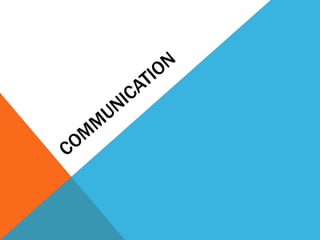
Communicating Effectively
- 2. We communicate with people everyday. - Verbal - Non Verbal/Body Language - “I” Messages - Listening
- 4. PASSIVE COMMUNICATION CHARACTERISTICS Passive- unwilling or unable to express thoughts and feelings in a direct or firm manner • Blushes when someone looks his/her way • Agrees with EVERYONE. • Buys from every door-to-door salesman • Uses phrases like “A person I know said” or “They say” • Takes the blame for anything that happens • Makes other feel guilty by letting them walk all over him/her • Apologizes often in conversation What’s it like to communicate with someone like this?
- 5. AGGRESSIVE Aggressive- overly forceful, pushy, or hostile. • Tells others what he/she wants and then talks them into it • Blows his/her stack when anyone disagrees • Rams his/her opinions down other people’s throats • Demands an explanation for other people’s behavior, such as “Why do you have to…” • Very Critical of others • Listens by interrupting • Must be in charge • Gets even with sarcasm Know anyone like this? How easy is it to be around them?
- 6. PASSIVE AND AGGRESSIVE COMMUNICATION
- 7. ASSERTIVE Assertive- express views clearly and respectfully • Buys only what he/she needs from door-to-door salesmen • States his own opinion matter of factly • Negotiates and makes compromises when needed • Smiles frequently • Takes credit when credit is due • Does not NEED to win an argument • Can admit if he/she is wrong • Cooperates well with others • Listens when others speak Of the three types, assertive communicators are most successful. How come?
- 8. So what?
- 10. NONVERBAL COMMUNICATION • Body Language: nonverbal communication through gestures, facial expressions, behaviors, and posture. • Sometimes WHAT we say isn’t important as HOW we say it. • Everything we do sends a message!
- 11. NON VERBAL CUES ACTIVITY
- 12. WHAT DIFFERENT NONVERBAL CUES MEAN Crossed Arms Mirroring Closed off. Implies resistance. Shows interest. You find the Not listening or interested. speaker favorable. A nose rub Forward lean/decrease in Linked with deception. Could backwards lean mean you’re lying or trying to hide Indicates positive sentiment and the truth. interest. A barrier Eye Contact You’re too close. Back off. Shows interest, attention, and involvement. A hand placed under the chin Contemplative. Making a decision. Raised Eyebrow Feet pointed toward the door May indicate skepticism or interest, depending on how it is Ready to leave. The feet are the done. most honest part of the body. What direction are they facing? Avoiding Eye Contact dishonesty or discomfort A back of the neck scratch Concerned or have questions.
- 13. WHY ARE NON VERBAL SKILLS IMPORTANT?
- 14. SPEAKING SKILLS • “I” Message: a statement that focuses on your feelings rather than someone else’s behavior. • Replace “You” messages with “I” messages
- 15. “I” MESSAGES 3 Ingredients • Event • Consequence of the event • Feeling • How that event made you feel?